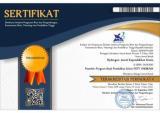An Analysis of Essential Amino Acid Contents of Canistel Fruit (Pouteria campechiana) as A Source of Vegetable Protein in An Effort of Food Diversification
DOI:
https://doi.org/10.33394/hjkk.v12i1.10491Keywords:
canistel fruit, amino acid, food diversificationAbstract
Canistel fruit is a fruit that is not cultivated and is not known to many people because of limited information about this fruit. In the field of biochemistry, analysis of the essential amino acids contained in canistel fruit has never been carried out. The aim of this research is to determine the type and levels of essential amino acids in Canistel fruit as a source of vegetable protein in an effort to diversify food. The sample used was Canistel fruit. The method used was chromatography using UPLC with a C18 column, PDA detector, gradient pump system, and column temperature of 49â°C. 15 types of amino acids were obtained, consisting of 7 essential amino acids and 8 non-essential amino acids. Essential amino acids are L-Fenilalanin (994,64 mg/kg), L- Isoleusin (704,58 mg/kg), L-Valin (876,69 mg/kg), L-Lisin 1.068,36 mg/kg), L- Leusin (1.199,45 mg/kg), L-Treonin (857,16 mg/kg), and LHistidin (421,03 mg/kg)and 8 non-essential amino acid are L-Serin (957,38 mg/kg), L-Asam glutamat (2.137,7 mg/kg), L-Alanin (1.070,01 mg/kg), LArginin (838,15 mg/kg), L-Glisin (1.101,56), L-asam aspartate (1.900,63 mg/kg), L-Tirosin (141,90 mg/kg), and L-Prolin (1.146,84 mg/kg).
References
Adyas, E. E., Gz, S., Sc, M., Dzulhijjah, R., Gz, S., & Gz, M. (2022). Analisis Kandungan Gizi Produk Olahan Buah Campolay (Pouteria Champeciana). JKBH (Jurnal Kesehatan Bogor Husada), 2(1), 8–14.
Alia Tejacal, I., Villanueva-Arce, R., Pelayo-Saldivar, C., Colinas-Leon, M. ., Lopez Martinez, V., & Baustista-Banos, S. (2007). Activity Physiology and Technology of Sapote Mamey Fruit Pouteria sapota (Jacq.). H.E. Moore & Stearn Biology and Technoloy, 45, 285–297.
Aly, M. E., Nebal, D. E. T., Sherifa, F. M., Rabab, M. A., & Sally, A. W. E. A. (2016). Chemical composition and biological activities of Pouteria campechiana (Kunth) Baehni. Journal of Medicinal Plants Research, 10(16), 209– 215. https://doi.org/https://doi.org/10.5897/jmpr2015.6031
Anissa, D. D., & Dewi, R. K. (2021). Peran Protein: ASI dalam Meningkatkan Kecerdasan Anak untuk Menyongsong Generasi Indonesia Emas 2045 dan Relevansi Dengan Al-Qur’an. Jurnal Tadris IPA Indonesia, 1(3), 427–435. https://doi.org/10.21154/jtii.v1i3.393
Aseervatham G., S. B., Manthra, V., Ireen, C., Thilagameena, S., Akshaya, S., Clara, Mary, A., Giriprashanthini, S., & Sivasudha, T. (2019). Free radical scavenging potential and antihaemolytic activity of methanolic extract of Pouteria campechiana (Kunth) Baehni. and Tricosanthes tricuspidata Linn. Biocatalysis and Agricultural Biotechnology, 18. https://doi.org/https://doi.org/10.1016/j.bcab.2019. 101031
Azhar, M. (2016). Biomolekul Sel Karbohidrat, Protein dan Ezim. UNP Press.
Azurdia, C. (2006). Trees Species of Zapote in America Tropical. Southampton Centre for Unilited Crops, University of Southampton.
Costa, T., Silveira, D., Daniele, A., Wondracek, C., Lopes, R., & Vieira, S. (2010). Komposisi karotenoid canistel ( Sawo mentega ( Kunth ) Baehni ).
Damayanti, D. (2017). Ilmu gizi dan aplikasi. EGC Penerbit Buku Kedokteran.
Gifary, D. M., Pohan, E. N., Aziz, H. Al, Erlangga, H., & Muhammad, T. R. S. (2022). Pangan Di Indonesia Diversification of Food Ingredients As a Food Security. 49–58.
Gusnadi, D., & Suryawardani, B. (2022). Pemanfaatan Buah Alkesa (Pouteria Campechiana) dan Buah Naga Merah (Hylocereus Polyhizus) pada Produk Quick Bread Studi Kasus Pada Produk Madeliene, Pancake, dan Scone. Jurnal Inovasi Penelitian, 3(3), 5589-5594.
Khofifah, N., & Lestari, Y. N. (2022). Branched Chain Amino Acid ( BCAA ), Sitrulin , Bromelain Dan Muscle Injury. Bookchapter Kesehatan Masyarakat Universitas Negeri Semarang, 1, 128–160. https://doi.org/https://doi.org/10.15294/km.v1i1.71
Kong, K., Khoo, H., Prasad, N., Chew, L., & Amin, I. (2013). Total Phenolics and Antioxidant Activities of Pouteria Campechiana Fruit Parts. Sains Malaysiana, 42(2), 123–127.
Kubola, J., Siriamornpun, S., & Meeso, N. (2011). Phytochemicals, Vitamin C and Sugar Content of Thai Wild Fruits. Food Chemistry, 126(3), 972–981. https://doi.org/https://doi.org/10.1016/j.foodchem. 2010.11.104
Liu, J., Klebach, M., Visser, M., & Hofman, Z. (2019). Amino Acid Availability of a Dairy and Vegetable Protein Blend Compared to Single Casein, Whey, Soy, and Pea Proteins: A Double-Blind, Cross-Over Trial. Nutrients, 11(11). https://doi.org/10.3390/nu11112613
Mehraj, H., Sikder, R., Mayda, U., & Taufique, T. (2015). Plant Physiology and Fruit Secondary Metabolites of Canistel (Pouteria campechiana ). World Appl Sci J, 33(12), 1908–1914.
Muhammad, R. Z., Prihastanti, E., & Budihastuti, R. (2021). Pengaruh Wadah dan Suhu Penyimpanan yang Berbeda terhadap Kematangan Buah Sawo (Manilkara zapota L.). Buletin Anatomi Dan Fisiologi, 6(1), 42–48. https://doi.org/10.14710/baf.6.1.2021.42-48
Muliawati, N., Yuniarni, U., & R, C. (2002). Uji Aktivitas Antioksidan Ekstrak Etanol Daging Buah Sawo Walanda Pouteria campechiana ( Kunth ) Baehni dengan Metode DPPH. Prosiding Farmasi, 844–850.
Nuraini, D. (1991). Ketersediaan Lisin Sebagai Indidkator Mutu Protein. Warta III/P, Agro Based Industry, 8(2), 36–45.
Nurbaiti, L., Irawati, D., Wirabuanayuda, G., Warnaini, C., & Faradina Zubaidi, F. (2023). Profil Konsumsi Asam Amino Essensial Balita Stunting dan Tidak Stunting Di Kabupaten Lombok Utara. Prosiding SAINTEK LPPM Universitas Mataram, 5, 92–96.
Ochoa Gautier, J. B., Martindale, R. G., Rugeles, S. J., Hurt, R. T., Taylor, B., Heyland, D. K., & McClave, S. A. (2017). How Much and What Type of Protein Should a Critically Ill Patient Receive? Nutrition in Clinical Practice : Official Publication of the American Society for Parenteral and Enteral Nutrition, 32(1_suppl), 6S–14S. https://doi.org/https://doi.org/10.1177/0884533617693609
Poedjiadi, A. (1994). Dasar-Dasar Biokimia. UI-Press.
Puspita, D., Kurniawan, Y. A., Aiboi, Y., Pangan, T., Wacana-salatiga, U. K. S., Gizi, I., & Wacana-salatiga, U. K. S. (2019). Carotenoid Butter Content from Canistel ( Pouteria campechiana ). Journal of Food and Life Sciences, 3(1), 1–9.
Rejeki Retna Pertiwi, S., Rohmayanti, T., Apriani, Y., & Silpia, M. (2022). Inovasi Produk Yogurt Rasa Buah Campolay Dan Peyuluhan Manajemen Pemasaran Di Umkm Sabilulungan, Kecamatan Dramaga Innovation Of Canistel Fruit Flavor Yogurt And Marketing Instructions In Sabilulungan Msmes, Dramaga District. 8(1), 1–9.
Rismayanthi, C. (2015). Konsumsi Protein untuk Peningkatan Prestasi. Medikora, 2(2), 135–145.
Silva, C. A. M., Simeoni, L. A., & Silveira, D. (2009). Genus Pouteria: Chemistry and biological activity. Brazilian Journal of Pharmacognosy, 19(2A), 501–509.
Solichah, K. M. (2022). Suplementasi Asam Amino dan Performa Olahraga. Tin Persagi, 69–76.
Thalacker-Mercer, A. (2020). Benefits and Adverse Effects of Histidine Supplementation. The Journal of Nutrition, 150(1), 2588S-2592S.
Vasco A.H. Goeltom, Christabel Sheren, Cindy Novianti, & Lydia Kurnia. (2022). Olahan Makanan Berbahan Dasar Buah Alkesa (Pouteria campechiana). Jurnal Agrifoodtech, 1(2), 23–33. https://doi.org/10.56444/agrifoodtech.v1i1.270
Wolfe, R. R., Baum, J. I., Starck, C., & Moughan, P. J. (2018). Factors contributing to the selection of dietary protein food sources. Clinical Nutrition (Edinburgh, Scotland), 37(1), 130–138. https://doi.org/https://doi.org/10.1016/j.clnu.2017.11.017
Downloads
Published
How to Cite
Issue
Section
Citation Check
License
License and Publishing Agreement
In submitting the manuscript to the journal, the authors certify that:
- They are authorized by their co-authors to enter into these arrangements.
- The work described has not been formally published before, except in the form of an abstract or as part of a published lecture, review, thesis, or overlay journal.
- That it is not under consideration for publication elsewhere,
- That its publication has been approved by all the author(s) and by the responsible authorities – tacitly or explicitly – of the institutes where the work has been carried out.
- They secure the right to reproduce any material that has already been published or copyrighted elsewhere.
- They agree to the following license and publishing agreement.
Copyright
Authors who publish with Hydrogen: Jurnal Kependidikan Kimia agree to the following terms:
- Authors retain copyright and grant the journal right of first publication with the work simultaneously licensed under a Creative Commons Attribution License (CC BY-SA 4.0) that allows others to share the work with an acknowledgment of the work's authorship and initial publication in this journal.Â
- Authors are able to enter into separate, additional contractual arrangements for the non-exclusive distribution of the journal's published version of the work (e.g., post it to an institutional repository or publish it in a book), with an acknowledgment of its initial publication in this journal.
- Authors are permitted and encouraged to post their work online (e.g., in institutional repositories or on their website) prior to and during the submission process, as it can lead to productive exchanges, as well as earlier and greater citation of published work.
Licensing for Data Publication
Hydrogen: Jurnal Kependidikan Kimia uses a variety of waivers and licenses, that are specifically designed for and appropriate for the treatment of data: Open Data Commons Attribution License, http://www.opendatacommons.org/licenses/by/1.0/ (default) Other data publishing licenses may be allowed as exceptions (subject to approval by the editor on a case-by-case basis) and should be justified with a written statement from the author, which will be published with the article.










